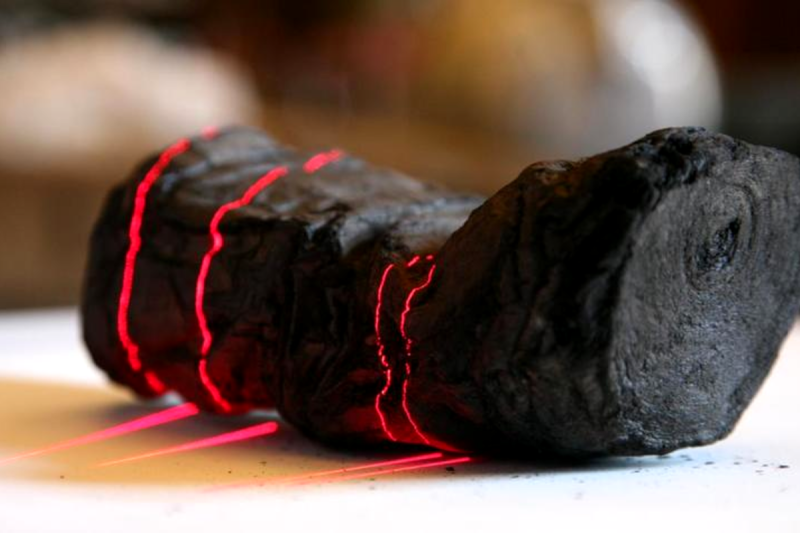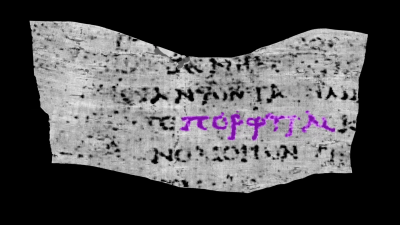
Imagine trying to read a 2000-year old scroll from an ancient civilization. Now imagine that scroll is rolled up, and in a delicate, charred, carbonized form, having been engulfed by the fiery eruption of a volcano. The task would seem virtually impossible, and the information in the scroll lost forever. Right?|
As it turns out, new developments are changing that. Modern scanning techniques and machine learning tools have made it possible to read fragments of the heavily-damaged Herculaneum scrolls. Hopes are now that more of the ancient writings will be salvaged, giving us a new insight into the ancient past.
Library Fire
The Herculaneum scrolls stand as a haunting reminder of the catastrophic eruption of Mt. Vesuvius in 79 CE, which entombed them. For centuries, these scrolls have been deemed “unreadable” due to the damage sustained from the eruption, leaving the wisdom contained within their tightly wound rolls inaccessible to the modern world. The scrolls were part of a library that is the only one to have survived from ancient times.
The bundles of scrolls were quickly carbonized due to the intense heat of volcanic matter from the eruption. Turned into delicate, charred blocks, they were then effectively preserved in this damaged state by the layers of rock that formed around them. They sat silently in their carbonized state, waiting for someone to unlock their secrets, until being discovered in 1752. A variety of methods were attempted over the years to unroll the scrolls and recover the information within. Whether mechanical, chemical, or otherwise, these methods often damaged or destroyed the scrolls entirely.
More recently, attempts have been made to decipher the remaining scrolls via a safer, non-contact method. Brent Seales, a computer science professor at the University of Kentucky, has been at the forefront of these efforts, involving the use of CT scans to image the scrolls non-destructively, before digitally “unrolling” them to be read. These techniques have been used to great success on other aged, folded transcripts. Often, the density of the ink compared to the paper makes it easy to find with a CT scan. Unfortunately, the carbon-based ink used on the Herculaneum scrolls complicated matters, as it does not readily stand out from the carbon-based papyrus itself on a CT scan.
New Methods Bear Fruit
The scrolls weren’t offering any low-hanging fruit, but Seales was undeterred. In 2019, a new method using a particle accelerator to X-ray the scrolls at higher resolution was used, with the hope that machine learning methods could identify tiny surface details that indicate the presence of the carbon-based ink on the page. Earlier this year, the techniques started to deliver promising results, with decoding the scrolls now looking more and more like a problem that could be solved with software.
Seales went on to establish the Vesuvius Challenge to help decode the scrolls from the scan data. The grand prize stands at $700,000 for the first team to read a scroll by December 31, 2023. To claim it, a team must read at least four separate passages of “continuous and plausible text,” each being at least 140 characters long. The prize has spurred people across the world to try and decode the scrolls using provided CT data. Now, the progress prize has been claimed, with two individuals receiving $40,000 and $10,000 each for decoding multiple letters, and even a whole word.

The breakthrough was made by challenge contestants Luke Farritor, a 21-year-old SpaceX intern, and Youssef Nader, an Egyptian biorobotics graduate student. Each individually discovered the same word in the scrolls, with Farritor being the first to achieve the milestone. The pair revealed the Greek characters πορφύρας, which translates to “purple dye” or “clothes of purple.” These characters are just a small fraction of the multiple characters and lines of text that have been extracted by the duo. Farritor and Nader used machine learning methods to virtually unwrap many layers of papyrus, revealing the ink within X-ray CT scans of the scroll. The results were independently verified by expert papyrologists, who assessed the letter shapes found for validity.

The Vesuvius Challenge was launched as a global competition to read the charred scrolls after Seales and his team demonstrated that an AI program could successfully extract letters and symbols from X-ray images of the unrolled papyri. Thousands of 3D X-ray images of two rolled-up scrolls and three papyrus fragments were released as part of the challenge, incentivizing global researchers and scholars to build upon the AI technology and expedite the decoding process.
The Vesuvius Challenge has succeeded in its mission to harness the collective intelligence of over a thousand research teams worldwide, all working together to solve a problem that would typically have only a handful of people working on it. The results have been nothing short of remarkable, proving that the seemingly impossible task of reading the Herculaneum scrolls is not so unachievable. It could potentially unlock one of the largest discoveries of written text from the ancient world.
As we look to the future, the race is on to read every unopened papyrus scroll in the collection, with over 600 scrolls still waiting to be decoded. The possibilities are limitless, with the potential to uncover ancient wisdom that has remained hidden for over 2,000 years. The Vesuvius Challenge has paved the way for a new era in the field of digital restoration, providing a blueprint for how we can use modern technology to unlock the secrets of the past and learn from the wisdom of ancient civilizations. As Seales aptly puts it, “Overcoming damage incurred during a 2,000-year span is no small challenge. But that’s what researchers do — together, we conquer the seemingly impossible.”
2000-Year Old Charred Manuscripts Reveal Their Secrets
Source: Manila Flash Report
0 Comments